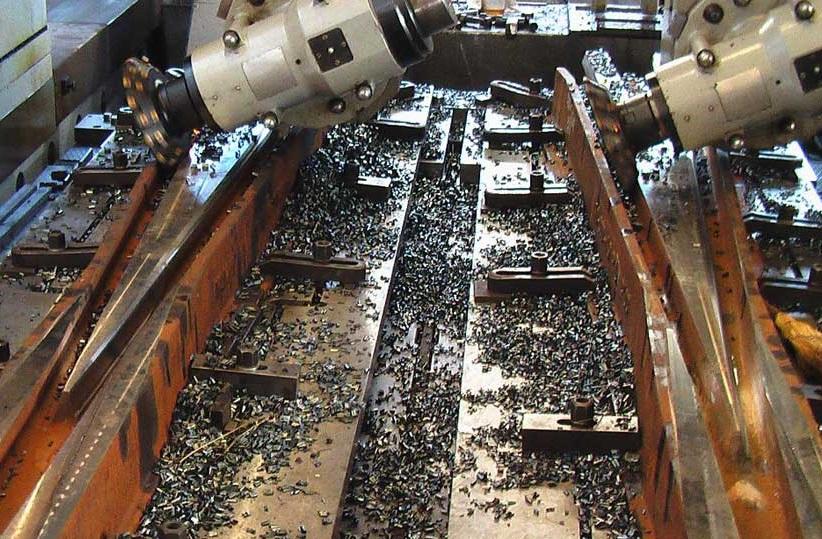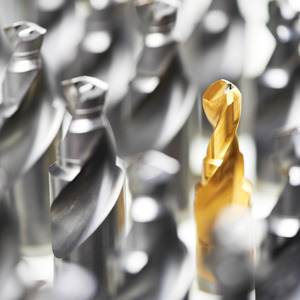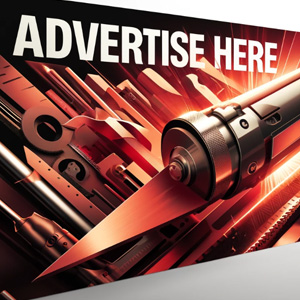Dormer Pramet’s Tools for the Railway Industry
Railway focused cutting tools can often be complex due to the specific requirement needed to machine a certain component in an efficient and exceptionally reliable manner. Hence, across many applications, the majority of cutting tools for the railway industry are classed as Specials, designed with the customer and operation in mind. But not all products.
There are several tools available within Dormer Pramet’s standard assortment, which can be used to support the production of various railway components. The company’s Penta HD and Econ HN, for example, are milling tools from its Pramet indexable range which can be used for various applications, including machining switches, base plates and wagon parts, such as frames, wheel axles and bogies.
Machining Switches
Rail switches and crossings are the sections that guide trains from one track to another. Dormer Pramet’s assortment encompasses tools for machining switches in all major rail profiles. The 60E1 and 60E2 rail profiles, for example, are the most common, especially in Europe. The type T section rail (flat bottom rails) is suitable for medium and heavy load traffic.
In the crossing part of the two rails, known as the frog, manganese steel, also known as Hadfield Steel, is used. An alloy steel, it is ideal for high impact environments. Manganese steel is not magnetic and has a very high abrasion resistance because the crossing must withstand the highest load on a railway track. It is a very tough material, with a low hardness (200-280HB), however, when it is machined, the hardness increases to more than 350HB. Another material used in the production of switches is Bainite steel, which is much easier to machine, even though it is a harder material at 450HB. It is ideally suited to this part of the track due to its high strength and wear resistance. Rail steel must be designed to be able to resist plastic deformation, rolling contact fatigue, bending and thermal stresses during the welding processes and renovations.

When machining switches, the design is usually made from a single component and therefore one of the first operations is roughing the top and bottom sections of the rail. This requires a large diameter cutter, enabling the fewest number of passes possible. Both the Penta HD and Econ HN assortments have indexable cutters up to 315mm diameter.
Penta HD
The Penta HD milling cutter was specifically developed with switches machining in mind. Allowing operators to utilize the full power of their machines, the Penta HD with PNMU insert is ideally suited to heavy roughing operations in a variety of material, including steels, stainless steels and cast iron.
Offering up to 10mm depth of cut and a feed rate of 0.7mm per tooth, the range enables high metal removal rates and productivity. Its double-sided insert design with ten cutting edges has an available length of 100mm, with each edge numbered for easier indexing.
In a recent test example, the Penta HD with PNMU insets, M chipbreaker and M8345 grade was able to machine 4,600mm of track in 39 minutes, with a cutting speed of 70m/min, a feed rate 0.33mm/tooth and an axial depth of cut (ap) at 7mm.
Another key feature of the Penta HD is the use of Dormer Pramet’s patented Sidelok technology system, which provides quick and easy clamping and release of the inserts. With a large retention screw permanently remaining in the cutter body, inserts can be quickly changed enabling more machine time and further increasing productivity.
Econ HN
Additional railway operations where standard tools can be used include the machining of base plates - the connecting element which ensures the rail is securely attached to the tie or sleeper. Also, wheel set axles, break-pad connectors, beam bolsters and bogie frames all require machining into shape.
For all these applications, customers demand high productivity, while at the same time, respecting specific production limitations and materials. In any initial machining, face milling cutters are usually the most suited tool. This allows for the removal of large amounts of metal and creates a smooth, flat surface and base, before specific shaping can be performed for connectivity with other components.
When machining the bottom part of base plates, for example, face milling cutters with diameters up to 160mm are often used. The Pramet Econ HN assortment offers a 45° face milling cutter, which is available from 25 - 315mm in diameter and includes the HNGX 06 and HNGX 09 inserts.
Designed to generate improved surface quality, the indexable range can perform both roughing (up to 6mm depth of cut), through to finishing (up to 1mm depth of cut). Its inserts have 12 cutting edges, with a wiper option for higher surface finish and is ideally suited to machining cast iron, as well as steels.
High insert density for high productivity and longer tool life, means lower cutting forces are required. Also, a differential tooth pitch and a unique geometry (F, M or R) for each operation, from finishing to roughing, along with an internal coolant supply, provides high tool accuracy and quiet running.
www.dormerpramet.com











